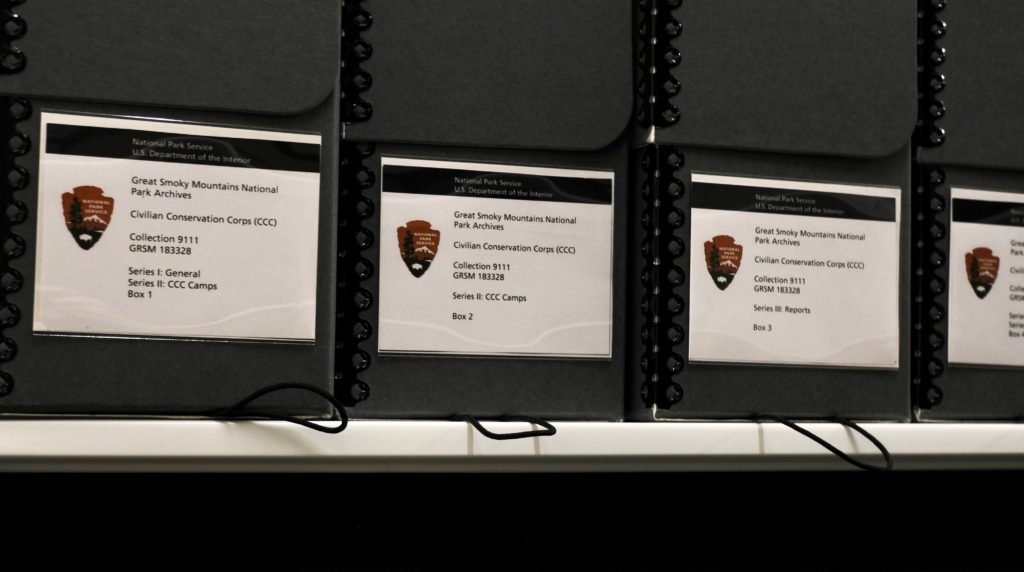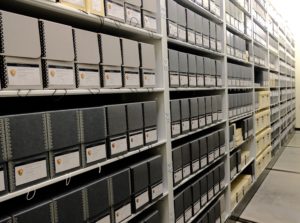By Michael Aday, Librarian-Archivist at the Collections Preservation Center at the Great Smoky Mountains National Park
This article appeared in the Volume 1, Issue 2 Fall 2019 issue of the Appalachian Curator. Click here to view a PDF of the full issue.
In May 2016 representatives of Great Smoky Mountains National Park, the National Park Service Southeastern Regional Office, Senator Lamar Alexander, and local dignitaries gathered in Townsend, Tennessee to cut the ribbon on a project that had been over 10 years in the making. That project, The National Park Service Collections Preservation Center, officially opened that day, though it would be several months before collection items would be moved into the facility. The 14,000 square foot structure was designed to house the cultural collections from 5 regional national park units: Great Smoky Mountains National Park, Obed Wild and Scenic River, Cumberland Gap National Recreation Area, Andrew Johnson National Historic Site, and Big South Fork National River and Recreation Area, as well as the archival holdings for Great Smoky Mountains National Park. The facility is the result of a public private partnership between the National Park Service, the Great Smoky Mountains Association, The Friends of the Smokies, and the Great Smoky Mountains Heritage Center.

The first collections moved into the facility were those of Great Smoky Mountains National Park. More than 1.5 million items were relocated to their new home in October 2016. For the first time in the history of the collection the park’s extensive cultural and archival collections are now housed under one roof and on park property. The history of the collection dates back to the parks creation in the 1930s. As residents of the Smoky Mountains were forced to move through the exercise of eminent domain, they left behind items of everyday use that were either too worn out or no longer of any practical use. Collected by early park employees Hiram Wilburn and Charles Grossman, among others, these items would become the core of a cultural collection that today numbers more than 35,000 items and includes archeological and ethnographic finds, textiles, artwork, furniture, tools, firearms, agriculture implements, and other items of everyday use.
Over the course of the next 3 years the other park service units moved their collections into the building. These consist primarily of archeological pieces from Big South Fork, Obed, and Cumberland Gap. Andrew Johnson National Historic Sites collection is made up of items not currently on display in the house museum.
In addition to the historic artifact collection, the facility houses nearly 1.4 million archival records related to the

history Great Smoky Mountains National Park. The archival collection spans a period from 1780 to 2016 and measures more than 1700 linear feet. The holdings include manuscript collections, audio and video collections, oral histories, historic photographs, maps, plans, and drawings, as well as federal records. This last category, the federal records generated by park management, represents the largest single collection in the repository. At more than 550 linear feet, this collection chronicles the management of the most visited National Park from 1930 to today. Among the noteworthy items in this collection are the bound superintendent’s monthly reports from 1934-1967, the Central Files which are the primary records documenting the management decisions of the park from 1931-1995, historic structure reports, as well as documents relating to the natural history of the park. Of particular interest are the records relating to some of the more controversial decisions made by park management including the Elkmont Historic District and the North Shore Road.
The archives at Great Smoky Mountains National Park is also a destination for genealogists. Due to the nature of the creation of the park through the exercise of eminent domain, there is a large collection of land transaction documents. Compiled by the Great Smoky Mountains Conservation Association and the North Carolina Parks Commission, these records document the chain of custody for more than 1000 individual parcels of land in North Carolina and Tennessee. Genealogists have mined the records for decades and have used their findings to write dozens of family histories. One researcher in particular, Donald Reagan of Gatlinburg, Tennessee used the information he gleaned from these documents to publish seven books on the history of the Reagan family in Tennessee. On his death in 2016 he donated his entire family research collection to the archives at the park, marking the single largest archival donation since the archival holdings were relocated to the new facility.

The collection also includes approximately 3500 hours of recorded and transcribed oral histories. The park began recording oral histories in 1934 when WPA employee Joseph Hall came to the Smokies to record traditional Appalachian folk music and the rapidly disappearing Southern Appalachian dialect. Though the original recordings are housed at the Library of Congress, copies and transcriptions are also available in the archives in Townsend. Also available are oral history recordings conducted with former residents of the area before it became a national park. Subjects were questioned about everyday life in Southern Appalachia, traditional mountain customs, as well as their feelings about the formation of the park.
The history of the Smoky Mountains is also documented in the archives collection of nearly 22,000 historic photographs. Comprised of images of early residents, Southern Appalachian lifeways, logging operations, and park service activities these images document the changes seen in this region of the mountain south. In 2014 Clemson University took over 14,000 images from the parks collection and made them available on the Open Parks Network. In 2016 Western Carolina University’s Hunter Library scanned images and documents for inclusion the digital collection Great Smoky Mountains a Park for America.
Though the Collections Preservation Center is open to the public Monday through Friday from 9 AM to 4 PM, an appointment is required. To make an appointment or discuss the collections please contact Michael Aday, at 865-448-2247 or michael_aday@partner.nps.gov.